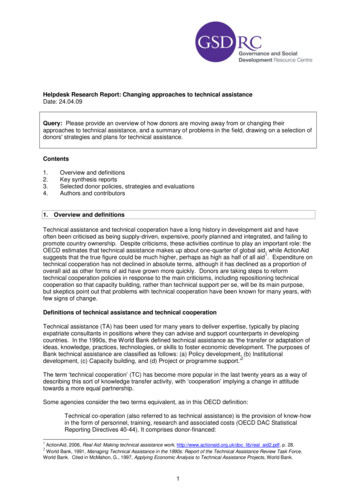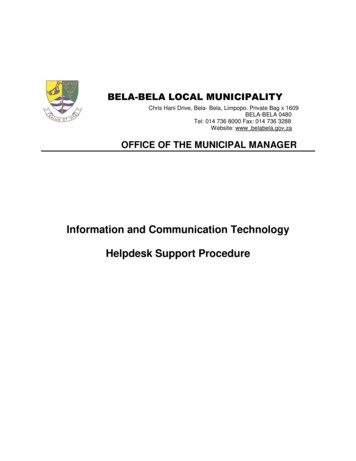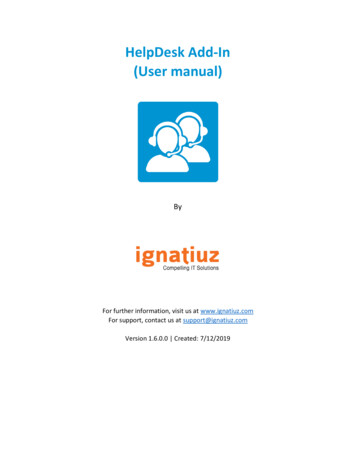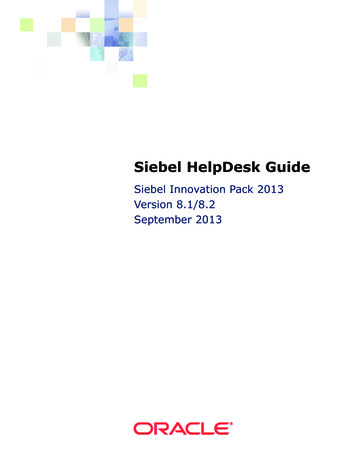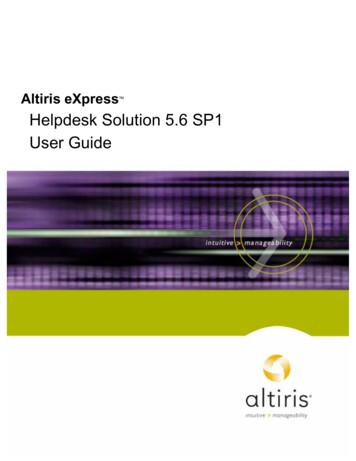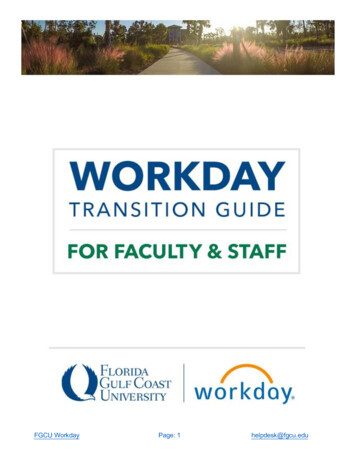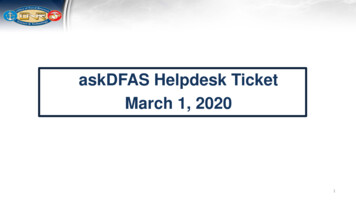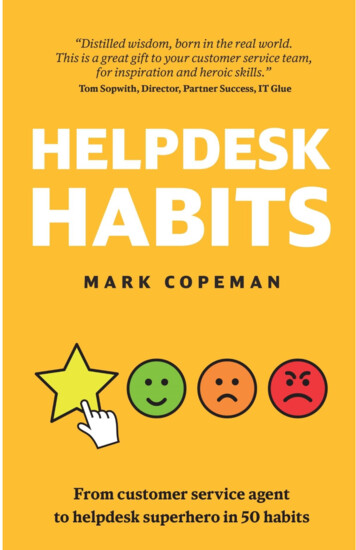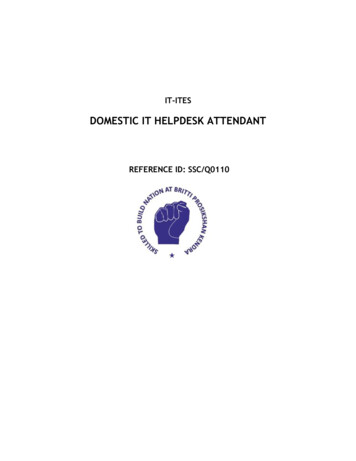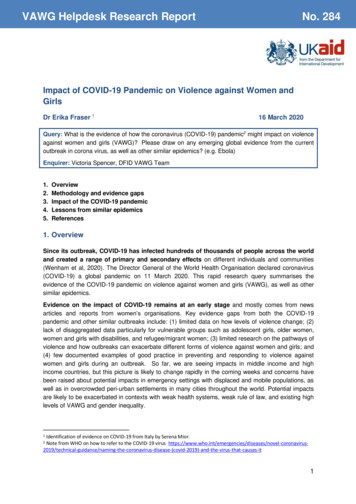
Transcription
VAWG Helpdesk Research ReportNo. 284Impact of COVID-19 Pandemic on Violence against Women andGirlsDr Erika Fraser 116 March 2020Query: What is the evidence of how the coronavirus (COVID-19) pandemic2 might impact on violenceagainst women and girls (VAWG)? Please draw on any emerging global evidence from the currentoutbreak in corona virus, as well as other similar epidemics? (e.g. Ebola)Enquirer: Victoria Spencer, DFID VAWG Team1.2.3.4.5.OverviewMethodology and evidence gapsImpact of the COVID-19 pandemicLessons from similar epidemicsReferences1. OverviewSince its outbreak, COVID-19 has infected hundreds of thousands of people across the worldand created a range of primary and secondary effects on different individuals and communities(Wenham et al, 2020). The Director General of the World Health Organisation declared coronavirus(COVID-19) a global pandemic on 11 March 2020. This rapid research query summarises theevidence of the COVID-19 pandemic on violence against women and girls (VAWG), as well as othersimilar epidemics.Evidence on the impact of COVID-19 remains at an early stage and mostly comes from newsarticles and reports from women’s organisations. Key evidence gaps from both the COVID-19pandemic and other similar outbreaks include: (1) limited data on how levels of violence change; (2)lack of disaggregated data particularly for vulnerable groups such as adolescent girls, older women,women and girls with disabilities, and refugee/migrant women; (3) limited research on the pathways ofviolence and how outbreaks can exacerbate different forms of violence against women and girls; and(4) few documented examples of good practice in preventing and responding to violence againstwomen and girls during an outbreak. So far, we are seeing impacts in middle income and highincome countries, but this picture is likely to change rapidly in the coming weeks and concerns havebeen raised about potential impacts in emergency settings with displaced and mobile populations, aswell as in overcrowded peri-urban settlements in many cities throughout the world. Potential impactsare likely to be exacerbated in contexts with weak health systems, weak rule of law, and existing highlevels of VAWG and gender inequality.1Identification of evidence on COVID-19 from Italy by Serena Mior.Note from WHO on how to refer to the COVID-19 virus s-it21
Emerging evidence suggests there are several ways in which the COVID-19 pandemic mayimpact on violence against women and girls: Increased risk of domestic violence. In China, police reports show domestic violence has tripledduring the epidemic. Domestic violence organisations have observed increased household tensionand domestic violence due to forced coexistence, economic stress, and fears about the virus. TheCOVID-19 outbreak has also curtailed access to support services for survivors, particularly in thehealth, police and justice sector. There is also some evidence that authorities have convertedwomen’s shelters into homeless shelters. In Italy, similar concerns have been raised about risinglevels of domestic violence. However, there are also examples of innovative practices to supportsurvivors including through technological solutions in China and Italy. Increased risk of workplace violence in the health sector due to the serious stress that thepandemic places on patients, their relatives and other healthcare workers. In China, there havebeen reports of physical and verbal attacks against frontline healthcare workers. In Italy, thenational healthcare workers union have raised concerns about attacks against doctors and nursesas COVID-19 overwhelms health resources and patients’ families become increasingly anxious. InSingapore, uniformed healthcare workers have been harassed in public spaces and on transport.There is not yet data on the gendered nature of violence, but research before the epidemic foundthat most violence is targeted at female nurses in emergency departments with long waiting times,in isolated places at patients’ homes, or in geriatric or psychiatric departments. Increased risk of racial and sexual harassment (both online and offline), with anecdotalreports of targeted sexualised attacks against women of East Asian appearance. In Delhi, forexample, female students from northeast India were verbally harassed, had objects thrown at theirprivate parts and their attackers shouted ‘Aye, coronavirus!’ Increased risk of abuse and exploitation for vulnerable women workers. In the United States,there have been reports of more coercive and violent behaviour against street-based sex workersin Seattle since the COVID-outbreak began. In Hong Kong, the migrant workers association havewarned that domestic workers (most of who are migrant women) are being made to work on theirday off, since the government told people to stay inside. Increased risk of VAWG in emergency settings, including refugee camps and IDP settlementswhere women may be at increased risk of different forms of violence, including sexual exploitationand abuse. In the Greek island of Lesbos, aid organisations report that women are at high risk ofsexual violence and already have limited access to healthcare. Fears are growing that the situationfor survivors is likely to deteriorate as health systems become overwhelmed with the first confirmedcase of COVID-19 on the island. In Lesbos, some aid organisations have also suspended servicesdue to harassment of aid workers from local anti-migrant groups. Increased risk of sexual exploitation and violence by state officials and armed guards. InChina and Iran, there have been some fears about increased state surveillance and officialsabusing their power, but no data yet on gendered state violence due to the pandemic.Experience from past epidemics suggests the importance of a ‘twin track’ approach,combining support to organisations working directly with survivors and integrating VAWG intosectoral responses (e.g. health, education, child protection, security and justice, social protectionand job creation). A summary of lessons from past epidemics is shown in the table below, based onexamples from outbreaks of Ebola (in West Africa and DRC), cholera (in Yemen), and Zika (in theCaribbean, Central and South America) (see Section 4 for further details).2
Lessons from other similar epidemicsProviding In past epidemics, women and girls were at increased risk of various forms ofviolence, with the most common forms being intimate partner violence and sexualexploitation and abuse. Specialised support services for Gender-Based Violence (GBV) survivors are inheavy demand during public health emergencies but remain limited in availabilityand funding is often deprioritised. Survivors of GBV can find it difficult to access healthcare due to restrictions onmovement and closed clinics. Fear of violence and mistreatment can prevent women from seeking healthservices during an epidemic. Fear of infection can prevent people accessing health services during anoutbreak, including life-saving care and support for GBV survivors. Epidemics can divert healthcare resources away from GBV services and sexualand reproductive health services. Concerns have been raised about sexual exploitation by health workers duringepidemics. Lack of supervision when caregivers are hospitalised can put adolescent girls andchildren at risk of abuse and maltreatment. There are increased risks of abuse, intimidation and harassment of frontline healthworkers, particularly women nurses. Communities report being intimidated by armed forces during outbreaks. Incountries with recent memories of conflict-related sexual violence committed byarmed forces, the deployment of security services during an outbreak can createfear and tension. There have also been reports of sexual exploitation by state officials andcommunity members charged with enforcing community level quarantine. Police and justice systems can become overwhelmed during an epidemic,creating an ‘atmosphere of impunity’ where GBV increases. Quarantine measures and the stress associated with epidemics can createhousehold tensions, leading to increased parental frustration and corporalpunishment. School closures can increase the risks for adolescent girls of different forms ofsexual exploitation and abuse, and early marriage. There are also increased risks of sexual exploitation and abuse associated withoutsiders who transport goods into the community and provide services and whodemand sex in return for assistance or take advantage of reduced caregiversupervision. Outbreaks can create and intensify child protection issues due to children beingseparated from caregivers, being stigmatised, and difficulties accessing services. Epidemics have both large immediate economic effects, as well as potentiallylong-term effects on economic activity. There is little evidence specifically from epidemics of the impact of economicinsecurity on VAWG. However, wider evidence shows that intimate partnerviolence and violence against children increase during times of economic stress. Promising practice from the Ebola epidemic includes cash transfer programmeswhich have integrated GBV elements, such as GBV and sexual exploitationtraining to mobile money agents and other distribution partners. There is little documented evidence on the specific impact of epidemics onVAWG in humanitarian settings; however, we know that there are often increasedrisks, including sexual violence and intimate partner violence in humanitarianemergencies. However, there are lessons in how to provide remote GBV case managementservices safely, which may be applicable during the COVID-19 epidemic.support tosurvivorsHealth sectorSecurity andjusticeEducationand childprotectionresponsesSocialprotectionand jobcreationHumanitariansettings3
Other important recommendations are shown in a box below.Recommendations highlighted in a recent note by the GBV Area of Responsibility and AsiaPacific Gender in Humanitarian Action Working Group3 include: Disaggregating data to understand the gendered impacts, with data disaggregated by sex,age, disability and other relevant vulnerability factors. Understanding which women and girls are at heightened risk of different forms of GBV andunderstand how these may vary across settings. Strengthening the leadership and meaningful participation of women and girls in all decisionmaking processes in addressing the COVID-19 outbreak Training first responders on how to handle disclosures of GBV that could be associated withor exacerbated by the pandemic, including how to make referrals for further care. Updating GBV referral pathways so as not to overwhelm tertiary hospitals Provide psychosocial support to GBV survivors who are also affected by the outbreak.2. Methodology and evidence gapsThe methodology for this query is described below.Search strategy: Studies were identified through searches using Google and relevant electronicdatabases (Science Direct, and Google Scholar). Due to the rapid and recent nature of the evidence,evidence was also identified on Twitter and other social media. Key search terms included:coronavirus, corona, COVID-19, Ebola, SARS, H1N1, Zika, disease, virus, outbreak, pandemic,epidemic AND GBV, VAWG, violence, violence against women, domestic violence, abuse,harassment, exploitation, rape, and trafficking.Criteria for inclusion: To be eligible for inclusion in this rapid mapping, evidence had to fulfil thefollowing criteria: Focus: Evidence on the impact of the COVID-19 virus pandemic and other similar epidemics onviolence against women and girls Time period: January 2000 – March 2020. Language: English and Italian, with targeted searches in Mandarin using Google Translate Publication status: publicly available – in all cases published online. Geographical focus: Global, with targeted searches on countries with the highest number ofcases4 as of mid-March 2020 (China, Italy, Iran, South Korea)Summary of evidence: Due to the very recent nature of the outbreak, evidence on the impact ofCOVID-19 remains at an early stage. The main source of evidence came from news reports and thewebsites of women’s organisations and those supporting survivors of violence in China and Italy. Nodata was found from Iran or South Korea (two other countries with large numbers of cases at the timeof writing this report). This paper also identified research from other similar epidemics – primarilyEbola (in DRC and West Africa), Zika (in the Americas), and Cholera (in Yemen). This evidenceincludes peer-reviewed journals and reports by INGOs and UN agencies.Evidence gaps: This review identified the following areas where there is limited evidence::3See note for full recommendations on gender and COVID-19: der4 Based on Worldometer’s daily ranking of countries: https://www.worldometers.info/coronavirus/4
Limited rigorous data available on how epidemics have changed levels of violence, withmost of the evidence based on the perceptions of communities or organisations working withsurvivors. There are considerable methodological, contextual and ethical challenges in obtainingprevalence and/or incidence data on GBV during epidemics, as is the case in other humanitarianemergencies (IASC, 2015). Lack of sex-disaggregated data on the impact of COVID-19 – a key step in identifying thosemost at risk of infection and with other protection needs (Smith, 2020) Evidence on the impact on vulnerable groups who may not seek support, testing or care due todistrust of surveillance by government and/or healthcare services (Smith, 2020), as well as groupsthat are at higher risk of VAWG, for example adolescent girls, older women, women and girls withdisabilities, and refugee/
VAWG Helpdesk Research Report No. 284 . 2 Emerging evidence suggests there are several ways in which the COVID-19 pandemic may impact on violence against women and girls: .
